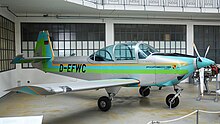MBB 223 Flamingo
Appearance
| 223 Flamingo | |
|---|---|

| |
| SIAT-built Flamingo at the Paris Air Show at Le Bourget Airport in June 1967 | |
| Role | Civil trainer aircraft |
| Manufacturer | SIAT, MBB, CASA |
| First flight | 1 March 1967 |
The MBB 223 Flamingo was a light aircraft developed in West Germany in the 1960s in response to a competition for a standard trainer for the country's aeroclubs. Designed by SIAT, it was a conventional low-wing monoplane with fixed tricycle undercarriage. The cockpit was enclosed by a large bubble canopy. SIAT had not undertaken much production of the type before the firm was acquired by MBB in 1970. Eventually, the new owners transferred production to CASA in Spain.
A fully acrobatic, single-seat version, and a four-seat utility version were also developed.
Variants

- Model 223A-1 Flamingo Trainer A1
- Two or four-seat trainer aircraft, powered by a 149-kW (200-hp) Avco Lycoming IO-360 piston engine.
- Model 223K-1 Flamingo Trainer K1
- Single-seat aerobatic aircraft, powered by a 149-kW (200-hp) Avco Lycoming AIO-360 piston engine.
- Model 223T-1 Flamingo Trainer T1
- One aircraft fitted with a turbocharged 157-kW (210-hp) Avco Lycoming TO-360-C1A6D piston engine.
- Model 223-M4
- The Model 223T-1 Flamingo Trainer T1 was later fitted with a Porsche PFM 3200 engine. One aircraft only.
Operators
Military Operators
Former operators
Specifications
General characteristics
- Crew: Two, pilot and instructor
Performance
References
Wikimedia Commons has media related to MBB 223 Flamingo.
- Taylor, Michael J. H. (1989). Jane's Encyclopedia of Aviation. London: Studio Editions. pp. 238, 638.
